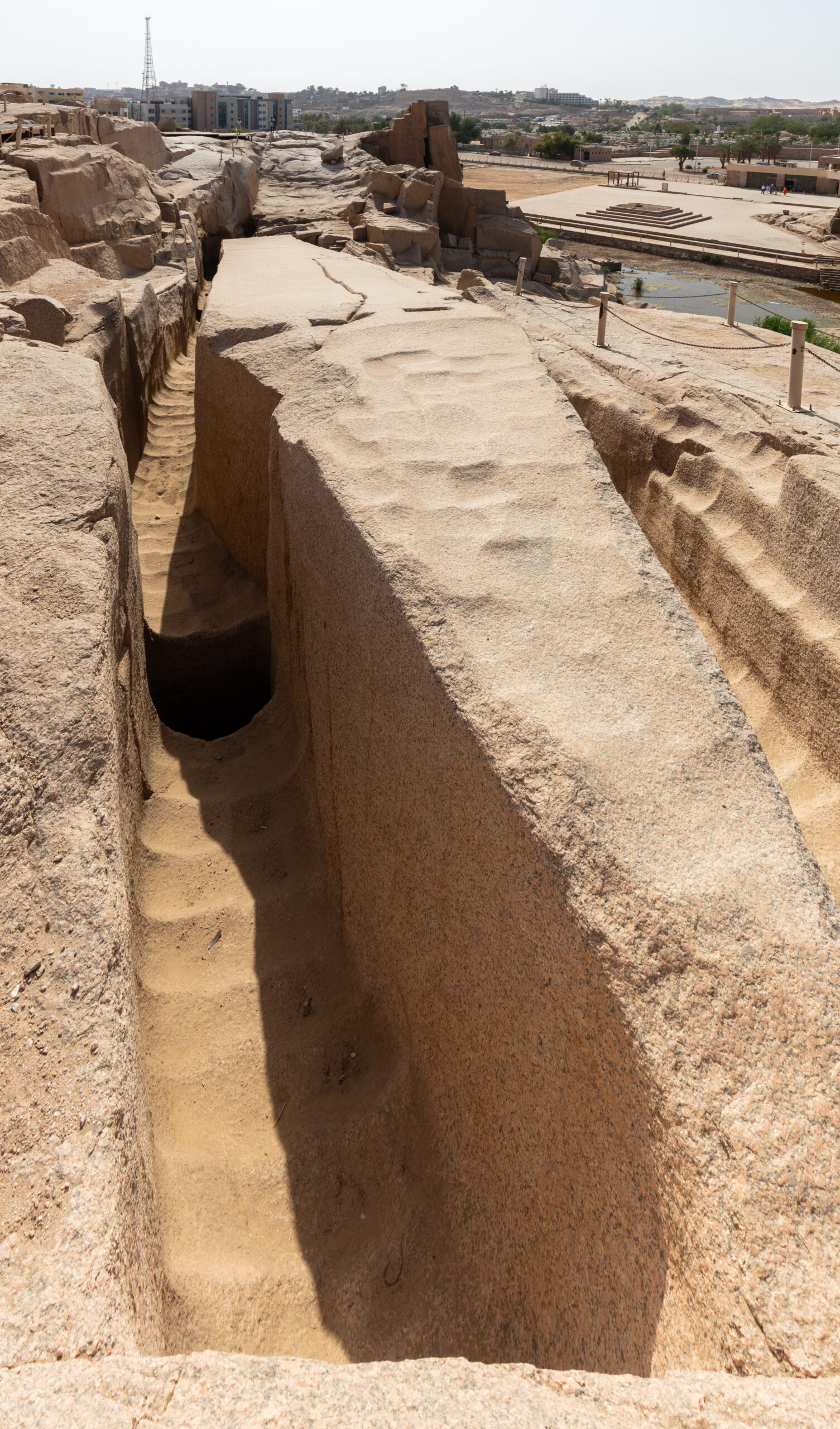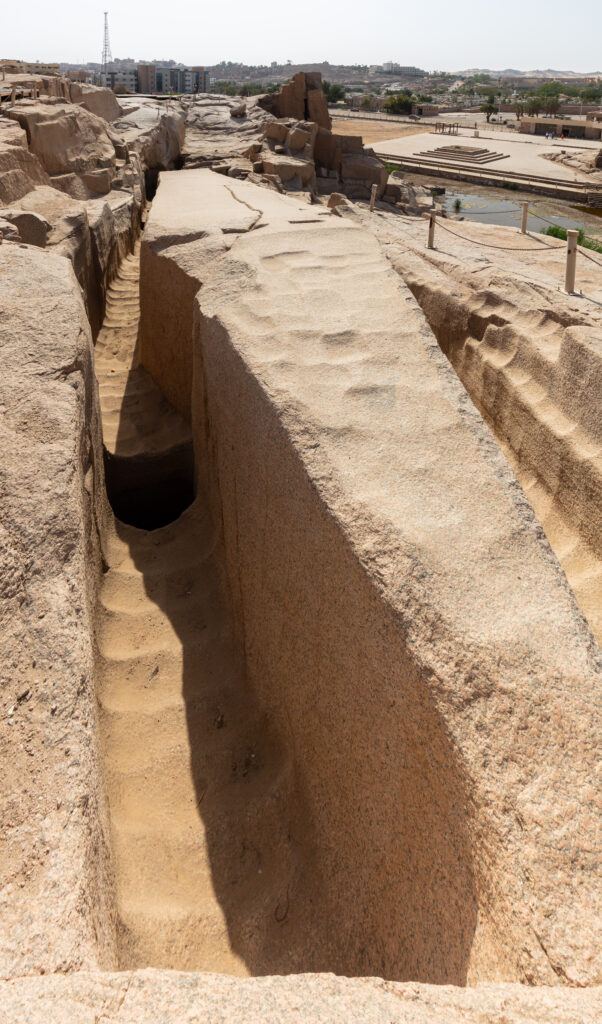Der fehlende Obelisk
Es handelt sich um den ältesten bekannten altägyptischen Obelisken und befindet sich im nördlichen Teil der antiken Steinbrüche in Assuan. Er wurde 1921 n. Chr. entdeckt und 1979 als Teil der Nubischen Monumente von Abu Simbel bis zur Insel Philae in die UNESCO-Welterbeliste aufgenommen.
Bedeutung des unvollendeten Obelisken
Die Bedeutung dieses unvollendeten bzw. unvollständigen Obelisken liegt in der Fülle an Informationen, die er über die Werkzeuge und Techniken liefert, die die alten Ägypter zum Schnitzen dieser prächtigen Obelisken verwendeten, die hoch vor Tempeln und in deren Innenhöfen stehen.
Der Körper der Obelisken verjüngt sich nach oben und endet in einer kleinen Pyramidenform. Die meisten Obelisken, insbesondere die großen, sind aus rosa Granit gehauen. Der fehlende Obelisk ist auch als Hatschepsut-Obelisk bekannt und stammt möglicherweise aus der Zeit der Königin Hatschepsut.
Dieser Obelisk wurde nie fertiggestellt, nicht aufgrund eines Fehlers der Arbeiter, sondern aufgrund eines ungünstigen Risses im Muttergestein. Der Obelisk steht noch immer an seinem ursprünglichen Standort, mit Ausnahme der Unterseite an allen Seiten abgetrennt. Wäre er ausgegraben worden, wäre er 41 Meter hoch gewesen, mit einer Basislänge von etwa 4,5 Metern und einem Gesamtgewicht von etwa 1.168 Tonnen.
Rund um die Stätte finden sich zahlreiche Dioritkugeln, die zum Schneiden dieser Obelisken aus dem Felsgestein verwendet wurden. Diorit galt als härter als Granit, daher wurden diese Kugeln um den Obelisken herum gehämmert, um ihn vom Fels zu trennen und herauszulösen. Diese schwarzgrünen Kugeln, manche vollständig, andere zerbrochen, haben einen durchschnittlichen Durchmesser von 15 bis 25 cm und wiegen zwischen 5 und 8 Kilogramm. Die Arbeiter benutzten sie als Hammerwerkzeuge, um den Stein zu schneiden.
In addition to its historical and architectural significance, the site in Aswan offers insight into the daily lives of ancient craftsmen. The surrounding quarry reveals not only the techniques used for large-scale stone carving but also the social organization behind such massive projects. Workers likely lived nearby, relying on a coordinated system of labor, tools, and planning. The precision of the work, even by today’s standards, is astonishing. Visiting the area allows travelers to connect deeply with ancient Egypt—not just through its temples and tombs, but through the raw, unfinished story of a monument that never reached the sky.
The Importance of the Unfinished Obelisk in Aswan
The Unfinished Obelisk in Aswan stands as one of the most remarkable and revealing archaeological sites in Egypt. Carved directly into the bedrock of an ancient granite quarry, this massive monument offers a rare and invaluable glimpse into the techniques and challenges faced by ancient Egyptian stonemasons. If completed, it would have been the largest obelisk ever constructed, measuring an estimated 42 meters in height and weighing over 1,000 tons.
Commissioned during the reign of Queen Hatshepsut in the 15th century BCE, the monument was likely intended to adorn the Karnak Temple in Luxor. However, a critical crack discovered during the carving process led to the abandonment of the project. This flaw preserved the site in its incomplete state and has become a unique window into ancient engineering methods. Tool marks and chisel lines are still visible on the surface, providing archaeologists with evidence of the labor-intensive techniques used to shape and extract obelisks from solid rock.
Beyond its archaeological value, the Unfinished monument underscores the ambition and skill of ancient Egyptian builders. The scale of the monument reveals their understanding of geometry, material strength, and transportation challenges—particularly the daunting task of moving such a massive object from the quarry to its final location, likely using sleds and Nile barges.
Today, the Unfinished monument is a major attraction in Aswan, drawing visitors and scholars alike. It not only enriches our understanding of ancient Egyptian construction but also symbolizes the enduring legacy of a civilization that aimed to reach monumental heights, even when nature intervened. Its preserved state makes it one of the most instructive sites for anyone interested in the wonders of ancient technology and the human drive to create lasting monuments.
Popular Hurghada Touren


